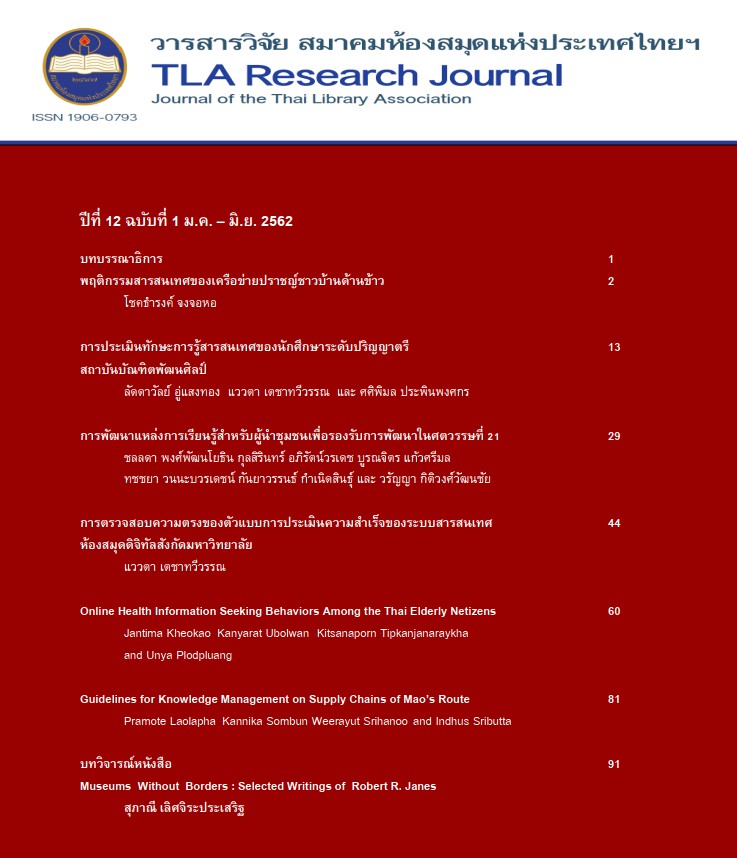การตรวจสอบความตรงของตัวแบบการประเมินความสำเร็จของระบบสารสนเทศห้องสมดุดิจิทัล สังกัดมหาวิทยาลยั
Main Article Content
บทคัดย่อ
การวิจัยนี้จึงมีวัตถุประสงค์เพื่อพัฒนาและตรวจสอบความตรงของตัวแบบการประเมินความสำเร็จของระบบสารสนเทศห้องสมุดดิจิทัลสังกัดมหาวิทยาลัย ซึ่งมี 6 องค์ประกอบ ได้แก่ คุณภาพของสารสนเทศ คุณภาพของระบบ คุณภาพของบริการ การใช้ประโยชน์ ความพึงพอใจ และความคุ้มค่า รวมทั้งตัวบ่งชี้ 21 ตัวบ่งชี้ โดยใช้วิธีวิจัยเชิงคุณภาพ กลุ่มตัวอย่างที่ใช้ในการวิจัย คือ นักศึกษา และอาจารย์/บุคลากรที่เป็นผู้ใช้ห้องสมุดดิจิทัลสังกัดมหาวิทยาลัย จำนวน 507 คน ซึ่งได้จากการสุ่มแบบสองขั้นตอน (Two-stage sampling) สถิติที่ใช้ในการวิเคราะห์ข้อมูล คือ สถิติเชิงพรรณนาและการวิเคราะห์องค์ประกอบเชิงยืนยัน ผลการวิจัยพบว่า ตัวแบบการประเมินความสำเร็จของระบบสารสนเทศห้องสมุดดิจิทัลสังกัดมหาวิทยาลัย มีข้อคำถาม จำนวน 52 ข้อ มีค่า IOC อยู่ระหว่าง 0.60 - 1.00 มีความเชื่อมั่นอยู่ระหว่าง 0.959 - 0.962 และโดยรวมมีค่าความเชื่อมั่น 0.961 ซึ่งแสดงว่ามีคุณภาพสามารถนำไปใช้ประเมินได้จริง นอกจากนี้ความเที่ยงเชิงโครงสร้างขององค์ประกอบทั้ง 6 องค์ประกอบ รวมทั้งการวิเคราะห์องค์ประกอบเชิงยืนยันทั้งอันดับหนึ่งและอันดับสอง มีค่าน้ำหนักองค์ประกอบมาตรฐานอยู่ในช่วง 0.87 - 0.96 มีค่าความเที่ยงอยู่ในช่วง 075 - 091 ผลการวิเคราะห์องค์ประกอบเชิงยืนยันอันดับที่สอง พบว่า องค์ประกอบที่เป็นปัจจัยความสำเร็จทั้ง 6 องค์ประกอบ มีค่าน้ำหนักองค์ประกอบมาตรฐานอยู่ในช่วง 0.93 – 0.98 โดยปัจจัยการใช้ประโยชน์มีค่าน้ำหนักความสำคัญมากที่สุด (0.98) รองลงมา คือ ปัจจัยความพึงพอใจ และปัจจัยความคุ้มค่า (0.97) ปัจจัยคุณภาพของสารสนเทศและปัจจัยคุณภาพของระบบ (0.94) ปัจจัยคุณภาพของบริการ (0.93) ตามลำดับ โดยทุกองค์ประกอบมีความสอดคล้องกับข้อมูลเชิงประจักษ์อย่างมีนัยสำคัญทางสถิติ (p = 0.360, CMIN/DF = 97.26, GFI = 0.98, AGFI = 0.96, RMSEA = 0.010, RMR = 0.013)
Article Details
บทความทุกเรื่องที่ลงตีพิมพ์จะได้รับการตรวจอ่านโดยผู้ทรงคุณวุฒิ ความคิดเห็นและบทความที่ปรากฏในวารสารนี้ เป็นของผู้เขียนซึ่งมิใช่เป็นความคิดเห็นของคณะผู้จัดทำ และมิใช่ความรับผิดชอบของสมาคมห้องสมุดแห่งประเทศไทยฯ การนำบทความในวารสารนี้ไปตีพิมพ์ซ้ำต้องได้รับอนุญาตจากคณะผู้จัดทำ
All articles submitted for publication will be reviewed by the academic reviewers. The editorial board and TLA claim no responsibility for the content or opinions expressed by the authors of individual articles or columns in this journal. Reprinting of any articles in this journal must be permitted by the editorial board.
References
Ahmad, M., & Abawajy, J. H. (2014). Digital library service quality assessment model. Procedia Social and Behavioral Sciences, 129, 571-580.
Ali, M., & Aasim, M. (2009). Usability evaluation of digital library: Blekinge Tekniska HÖgskolan a case study (Unpublished master’s thesis). Blekinge Institute of Technology, Karlskrona, Sweden.
Arms, W. Y. (2000). Digital libraries. Cambridge, MA: MIT Press.
Calhoun, K. (2014). Exploring digital libraries: Foundations, practice, prospects. London, UK: Facet.
Chore, N. V., & Salwe, S. M. (2010, April). Library sources and service. In Digital environment: Proceeding of State Level Seminar on Role of information technology in library, Karad, 8-9 April 2010.
DeLone, W. H., & McLean, E. R. (1992). Information systems success: The quest for the dependent variable. Information Systems Research, 3(1), 60-95.
DeLone, W. H., & McLean, E. R. (2002). Information systems success revisited. In Proceedings of the 35th Hawaii International Conference on System Sciences (HICSS 02) (pp. 238-249), BigIsland, Hawaii.
DeLone, W. H., & McLean, E. R. (2003, Spring). The DeLone and McLean model of information systems success: A ten-year update. Journal of Management Information Systems, 19(4), 9-30.
DeLone, W. H., & McLean, E. R. (2016). Information systems success measurement. Boston, MA: Now.
Doung-In, Suthanya. (2013, September-December). Applying social tools to digital libraries. Journal of Information Science, 31(3), 78-95. [In Thai]
Fuhr, N., Tsakonas, G., Aalberg, T., Agosti, M., Hansen, P., Kapidakis, S., et al. (2007). Evaluation of digital libraries. International Journal on Digital Library, 8(1), 21–38.
Gagne, P., & Hancock, G. R. (2006). Measurement model quality, sample size, and solution propriety in confirmatory factor model. Multivariate Behavioral Research, 41, 65-83.
Hongbil, Songsiri. (2001). A suitable digital library development model for King Mongkut’s Institute of Technology Ladkrabang (Unpublised master’s thesis). Ramkhamhaeng University, Bangkok. [In Thai]
Jeng, J. (2006). Usability of the digital library: An evaluation model (Doctoral dissertation). Retrieved from ProQuest Dissertations & Theses database (UMI No. 3203380)
Joo, S. (2010). How are usability elements-efficiency, effectiveness and satisfaction correlated with each other in the context of digital libraries? Retrieved from http://www.asis.org/asist2010/proceedings/ proceedings/ASIST_AM10/submissions/323_Final_Submission.pdf
Kaiwan, Yuth. (2014). Multivariate statistical analysis for research (2nd ed.). Bangkok: Chulalongkorn University. [In Thai]
Lagzian, F., Abrizah, A., & Wee, M. C. (2013). An identification of a model for digital library critical success factors. The Electronic Library, 31(1), 5-23.
Masrek, M. N., & Gaskin, J. E. (2016). Accessing users satisfaction with web digital library: The case of Universiti Teknolgi MARA. The International Journal of Information and Learning Technology, 33(1), 36-56. National Archives of Australia. (2017). Types of information. Retrieved from http://www.naa.gov.au/information-management/managing-information-and-records/typesinformation/index.aspx
National Information Standards Organization. (2007). A framework of guidance for building good digital collections (3rd ed.). Retrieved from http://www.niso.org/publications/rp/ framework3.pdf
Nielsen, J. (2012). Usability 101: Introduction to usability. Retrieved from http://www.useit.com/alertbox/20030825.html
Office of the Higher Education Commission. (2018). Higher Education Statistics 2015-2017. Retrieved from http://www.info.mua.go.th/info
Rangchaikul, Yaowadee. (2013). [Measurement and development of achievement tests] (11st ed.).
Bangkok: Chulalongkorn University. [In Thai]
Saracevic, T., & Covi, L. (2000). Challenges for digital library evaluation. In D. Soergel, P. Srivivasan, & B. Kwasnik (Eds.), Proceedings of the 11th ASIST Annual Meeting, 37 (pp. 341-350). Silver Spring, MD: Association for Information Science and Technology.
Stejskal, J., & Hajek, P. (2015). Evaluating the economic value of a public service-the case of the Municipal Library of Prague. Public Money & Management, 35(2), 145-152.
Suksakorn, Punnapa. (2016). Factors affecting the usability of the digital library at the National Library of Thailand (Unpublished master’s thesis). Ramkhamhaeng University, Bangkok. [In Thai]
Techataweewan, Wawta. (2019). Analysis of key success factors of academic digital library information systems to enhance higher education. In World Conference on Educational Sciences 2019, 7-10 February 2019, Milan, Italy.
Torres-Vargas, G. A. (2013). The design of a digital library for Mexican Universities. Procedia Social and Behavioral Sciences, 73, 751-756.
Wongman, Kanchana, & Phisalphong, Kwanchadil. (2016, January-April). The development of Thai Classic Dance and Music digital libarary for Chanthaburi College of Dramatic Arts, Bunditsilapa Phatana Institute. Journal of Humanities and Social Science, 24(44), 123-144. [In Thai]
Xie, H.I. (2006). Evaluation of digital libraries: criteria and problems from users’ perspectives. Library Information Science Research, 28(3), 433–452.
Xie, I., & Matsusiak, K. (2016). Discover digital libraries. Amsterdam, Netherlands: Elsevier.
Xu, F., & Du, J. T. (2018). Factors influencing users’ satisfaction and loyalty to digital libraries in Chinese universities. Computers in Human Behavior, 83, 64-72.

